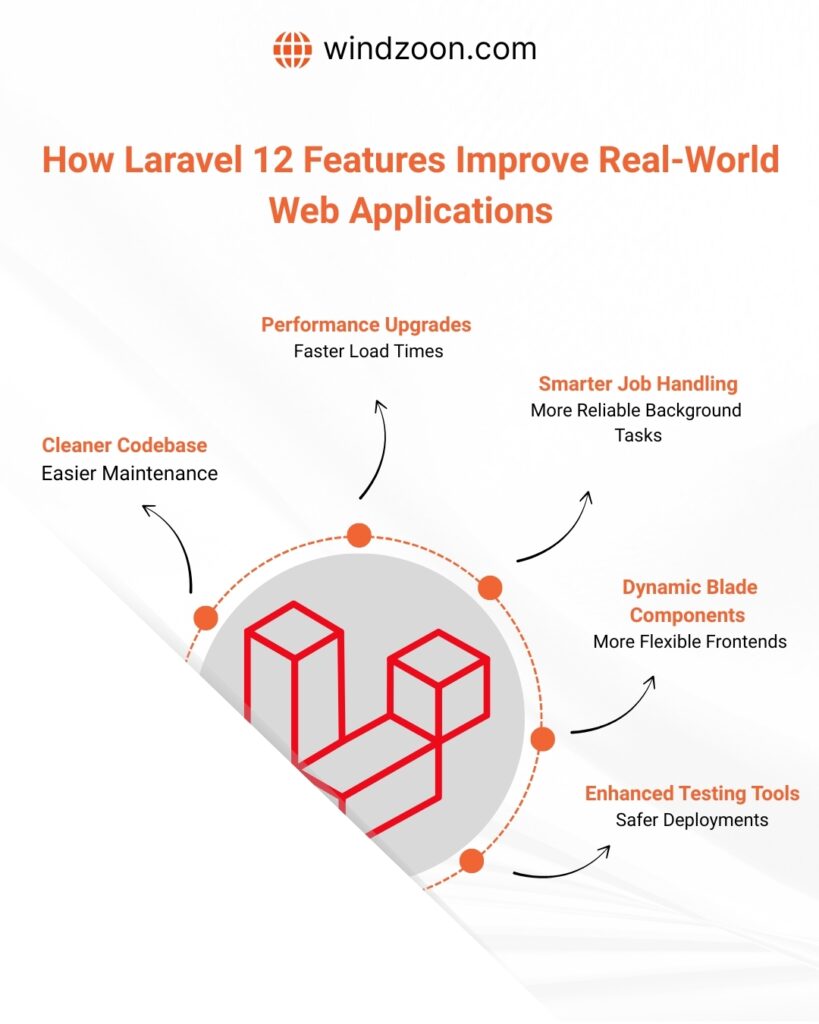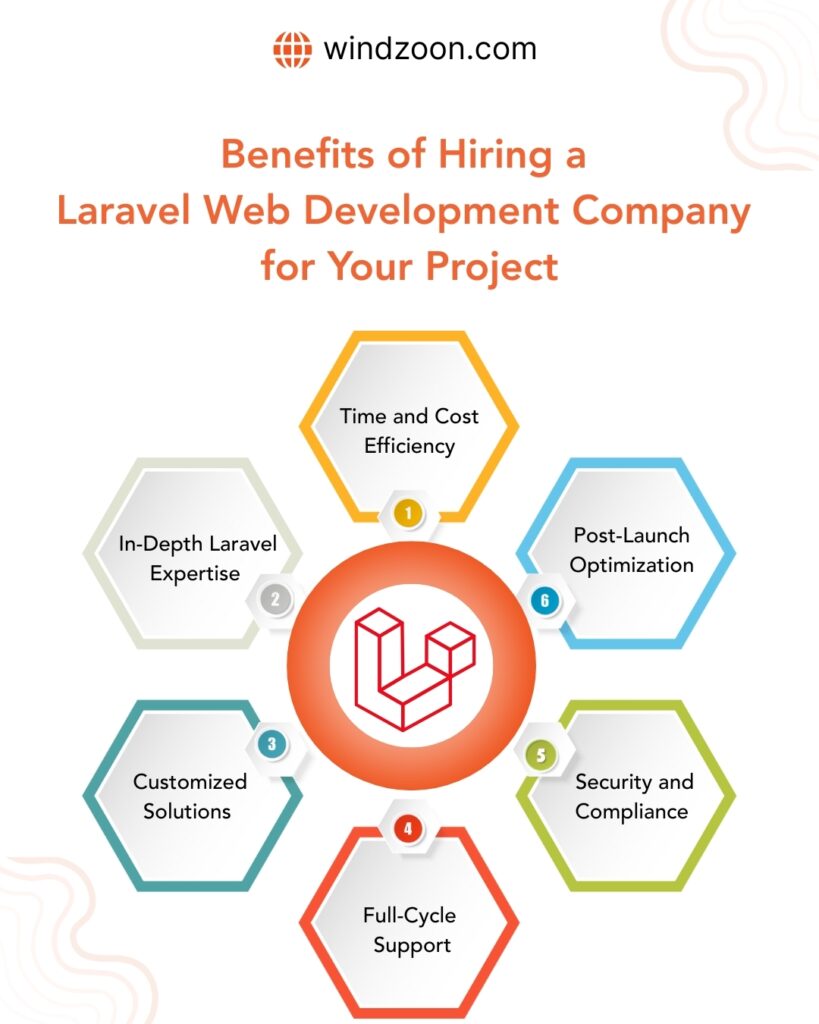In the fast-evolving world of web development, staying in sync with the latest frameworks isn’t just helpful, it’s essential. Laravel, one of the most trusted PHP frameworks, continues to set the standard with its clean syntax, robust features, and elegant architecture. With the release of Laravel 12, developers now have even more tools to build powerful, modern web applications efficiently.
But here’s the thing: Laravel 12 isn’t just a minor update. It brings along a series of enhancements, from streamlined starter kits to next-level support for frontend tools, that reshape how developers craft applications in 2025.
Let’s begin by revisiting what Laravel actually is and why it’s become a developer’s favorite over the years.
What is Laravel Framework, and Why Is It Popular in Web Development?
An open-source PHP framework called Laravel makes it easier to create scalable and reliable online apps. At its core, it follows the MVC (Model – View – Controller) architectural pattern, which cleanly separates the logic, presentation, and data layers of an application. But Laravel goes beyond just structure; it’s a toolkit filled with thoughtful features that make a developer’s life easier.
Consider Laravel to be PHP’s Swiss Army knife. It comes with built-in tools for routing, authentication, database migrations, caching, and more. You don’t have to start from scratch every time you build something. Instead, Laravel gives you the foundations and the shortcuts to get up and running fast, without sacrificing quality.
Why is Laravel so popular?
Here’s why developers and businesses alike keep choosing Laravel:
- Expressive Syntax: Laravel’s code reads like English. It’s easy to write, easy to understand, and easy to maintain, especially for teams.
- Strong Community Support: There’s a huge ecosystem of packages, forums, and tools, making it easier to solve problems and build faster.
- Security at its Core: Features like CSRF protection, hashed passwords, and robust authentication make it a secure framework for serious applications.
- Effortless Integrations: Whether you want to add payment gateways, email services, or APIs, Laravel handles it smoothly.
- Elegant Tools: Laravel offers polished tools like Eloquent ORM, Laravel Mix, and Artisan CLI that streamline tasks that most frameworks make tedious.
All of these reasons are why countless startups, SMEs, and large enterprises choose to work with a professional Laravel web development company; they want the flexibility and reliability Laravel offers, without getting lost in technical complexity.
Now that we’ve understood Laravel’s foundation and its growing relevance, let’s take a brief look back at how it has evolved over the years and what brought us to version 12.
Laravel Version History: From Laravel 5 to Laravel 12
To fully understand the significance of Laravel 12, it’s important to look at how Laravel has progressed over the years. The framework has evolved not only in its capabilities but also in its approach to modern web development, becoming one of the most trusted PHP frameworks in the industry.
Laravel 5: Laying the Groundwork for Scalability
Released in 2015, Laravel 5 introduced several architectural changes that defined the direction of the framework:
- Artisan command improvements
- Middleware support for filtering HTTP requests
- Request validation via Form Requests
- Introduction of service providers and dependency injection
This version laid the foundation for Laravel’s structured and maintainable development approach.
Laravel 6 and 7: Transition to Semantic Versioning
Laravel 6 adopted semantic versioning (SemVer) and introduced long-term support (LTS). Key highlights included:
- Laravel UI, which separated frontend scaffolding from the core
- Lazy collections for improved memory efficiency
- Job middleware and better exception handling
Laravel 7 built on this by introducing:
- Blade component tags
- HTTP client for simplified external API requests
- Route model binding enhancements
Laravel 8: Smoother Developer Experience
Laravel 8 was a major step forward in terms of developer productivity. It introduced:
- Laravel Jetstream for modern authentication scaffolding
- Dynamic model factories
- Event listener improvements and better job batching
- Improvements to route caching and model factory design
It became a widely adopted version thanks to its balance between modern tooling and backward compatibility.
Laravel 9: Advancing with Symfony 6
Laravel 9 was released as an LTS version and aligned with Symfony 6 components. Notable upgrades included:
- Full support for PHP 8
- Improved query builder with type hints
- Enum casting for Eloquent models
- Flysystem 3.x integration for file storage
This version further solidified Laravel’s place in enterprise-grade development.
Laravel 10: Refinement and Type Safety
Laravel 10 focused on simplifying code and improving maintainability. Key updates were:
- Native type declarations across the codebase
- Removed deprecated methods and properties
- New process abstraction for handling system processes
It was aimed at creating cleaner, more predictable codebases.
Laravel 11 and 12: The Modern Laravel Era
Laravel 11 introduced structural simplifications, removing unnecessary boilerplate and focusing on minimalism. By the time Laravel 12 arrived, the framework was streamlined and more powerful than ever:
- Modular and composable application structure
- Enhanced testing tools
- Improved route groups and middleware management
- Support for the latest PHP versions and performance enhancements
These versions reflect a shift toward developer-focused efficiency and production-level performance.
For any business planning a web application, understanding Laravel’s evolution helps clarify why partnering with a reliable Laravel web development company can make a significant difference.
Up next, we’ll explore Laravel 12.x in detail and walk through the most important features introduced in its latest versions.
Laravel 12.x Features Explained – From 12.0 to 12.19
Laravel 12 isn’t just one version; it’s a series of consistent, thoughtful updates that show how the framework continues to grow with developer needs in mind. Starting from version 12.0 and rolling through to 12.19, each release brought meaningful improvements, feature refinements, and performance boosts.
Let’s break down the most notable changes across these versions to help you understand the evolution and what makes Laravel 12.x especially appealing.
Laravel 12.11 to 12.15 – Focus on Performance
- Route Caching Optimization: Large apps with hundreds of routes saw faster boot times and improved memory usage.
- Model Bootstrapping Tweaks: Eloquent model behavior during boot was refined to be less error-prone and more predictable.
Laravel 12.16 to 12.19 – Modern Development Ready
- Enhanced Job Retry Logic: Queued jobs now handle failure retries more gracefully, especially in distributed systems.
- Updated Prompts and Console UI: Artisan prompts were made more interactive, enhancing developer experience in the terminal.
- Support for Native Types in Policies and Middleware: Making the codebase leaner and safer, this change allowed native PHP type hints to be used more widely.
Why These Features Matter
From cleaner file structures to performance tuning and smarter tooling, Laravel 12.x is all about working with the developer, not against them. It empowers teams to write less boilerplate, build faster, and maintain clarity, even in large, complex apps.
For businesses looking to stay ahead of the curve, working with a seasoned Laravel web development company ensures these features are not just understood but fully leveraged in real-world projects.
Next, we’ll dive into how these Laravel 12.x enhancements actually impact real-world application development.
How Laravel 12 Features Improve Real-World Web Applications

It’s one thing to read about new features in a changelog. It’s another to understand how they actually improve the experience of building and maintaining web applications. Laravel 12.x doesn’t just offer bells and whistles; it brings tangible benefits that directly impact performance, scalability, and developer productivity.
Let’s walk through how these features play out in real-world projects:
1. Cleaner Codebase = Easier Maintenance
The simplified app structure introduced in Laravel 12.0 helps developers start with a minimal setup and grow organically as needed. In long-term projects, this translates to fewer unused files, less clutter, and a cleaner codebase that’s easier to manage.
For businesses, this means reduced technical debt and faster onboarding of new developers.
2. Performance Upgrades = Faster Load Times
Improvements in route caching and query optimization aren’t just technical jargon; they lead to quicker response times. Whether you’re running an eCommerce platform or a SaaS product, speed matters. Laravel 12 makes apps feel snappier even as they scale.
A Laravel web development company can help fine-tune these settings to squeeze out every bit of performance.
3. Smarter Job Handling = More Reliable Background Tasks
With better job retry logic and batch monitoring, Laravel 12 ensures background tasks like sending emails, processing files, or syncing data don’t silently fail. In real-world applications, this boosts reliability and keeps business processes running smoothly.
4. Dynamic Blade Components = More Flexible Frontends
Laravel’s Blade engine now makes it easier to reuse UI components across pages, reducing duplication and allowing faster development of complex interfaces. This is especially helpful for admin panels, dashboards, and content-heavy sites.
5. Enhanced Testing Tools = Safer Deployments
Integrated support for Pest testing encourages developers to write expressive, easy-to-read tests. When a product is tested well, it ships with confidence and fewer bugs.
Real Value for Businesses
These aren’t just upgrades for the sake of change. They’re carefully crafted improvements that solve common pain points in modern web development.
Partnering with a Laravel web development company ensures your application is built not only with the latest tools but also with best practices that make the most of Laravel 12’s capabilities.
Coming up next: how to choose the right Laravel partner to bring all of this to life.
Benefits of Hiring a Laravel Web Development Company for Your Project

While Laravel offers a powerful and elegant framework for building web applications, getting the most out of it requires more than just familiarity with the syntax. This is where a Laravel web development company steps in, not just as a coding team, but as a strategic technology partner.
Here’s how your project benefits when professionals handle the Laravel stack:
1. In-Depth Laravel Expertise
Laravel evolves rapidly. A dedicated team stays updated with each release, including subtle but crucial changes in the 12.x versions. They understand how to leverage these updates to build secure, scalable, and efficient applications.
2. Time and Cost Efficiency
Instead of navigating the learning curve or spending time troubleshooting, hiring a Laravel-focused team means faster development cycles. You save time and money by avoiding common pitfalls and rework.
3. Customized Solutions
Every business has different needs. A seasoned Laravel web development company won’t just use templates; they’ll create tailored solutions that align with your goals, user base, and industry-specific challenges.
4. Full-Cycle Support
From idea validation and UI/UX design to deployment and maintenance, you get end-to-end support. You don’t need to juggle multiple vendors; one experienced Laravel partner can manage your entire tech stack.
5. Security and Compliance
Laravel offers built-in tools for CSRF protection, data encryption, and user authentication. A development company knows how to implement them properly to protect your application from vulnerabilities and ensure compliance with relevant standards.
6. Post-Launch Optimization
After launch, performance tuning, SEO best practices, and feature scaling become critical. A Laravel web development company continues to support your app, helping it grow and adapt as your business evolves.
In short, working with the right Laravel team doesn’t just result in a functioning web app; it creates a solid digital product built to scale, secure, and succeed.
Next, let’s wrap things up with a conclusion and some guidance on how to move forward if you’re planning to adopt Laravel 12 for your next big project.
Final Thoughts on Laravel 12
Laravel 12 brings a refined, developer-friendly approach to building modern web applications. Its new features aren’t just technical upgrades; they’re practical tools that simplify development and improve performance across real-world projects.
To truly make the most of these advancements, it’s smart to work with professionals who live and breathe Laravel. That’s where Windzoon Techno Pvt Ltd comes in, your trusted Laravel web development company dedicated to turning bold ideas into scalable digital products. Let’s build something great, together.
FAQs
1. What makes Laravel 12 better than previous versions?
Laravel 12 introduces improved type safety, enhanced syntax, and more efficient development tools. These updates help reduce errors, streamline workflows, and build scalable applications faster than before.
2. Is Laravel 12 suitable for enterprise-level applications?
Yes, Laravel 12 is built for projects of all sizes, including large-scale enterprise apps. Its powerful tools, modular structure, and active community support make it a reliable choice for complex business needs.
3. Why should I hire a Laravel web development company instead of a freelance developer?
A Laravel web development company brings a team of experienced professionals, structured workflows, long-term support, and quality assurance, ensuring your project is delivered on time and aligned with your business goals.
4. How can a Laravel web development company help with Laravel 12 migration?
If you’re running an older version of Laravel, a professional company can assess your current setup, handle the upgrade process safely, and implement Laravel 12 features without disrupting your app’s performance.





 +91 9904713335
+91 9904713335
